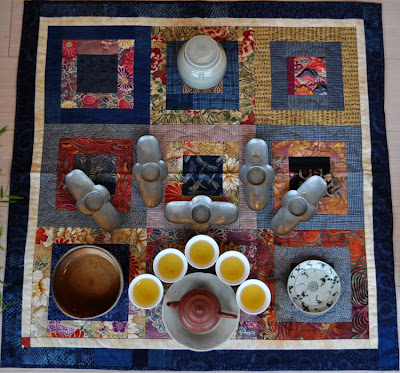 Le manque d'eau (sécheresse) est autant un problème que le trop plein (inondations).
Le manque d'eau (sécheresse) est autant un problème que le trop plein (inondations). Ce Cha Xi, ce set up, montre une oasis (un bol en céladon) autour d'un volcan (la théière Shi Piao). De là jaillit un liquide doré qui donne vie à 4 soleils dans des coupes en porcelaine couleur d'ivoire. Ce Baozhong torréfié assèche la bouche et se tranforme en moelleux. Les eaux usées disparaissent au fond d'un bol de Jianyang, tel un trou noir. Cette eau vient à manquer dans ce tableau au couleurs chaudes d'une fin d'après-midi estivale. On voit simplement 4 fleurs en tissus anciens et flétries, et une vraie fleur au rouge vif. Sur le tissu clair couleur de sable, les gouttes de thé laissent leur marque. Cela nous incite à faire attention de ne pas en verser à côté. L'eau et, plus encore, le thé sont précieux. Sachons ne pas les gaspiller, mais profitons de chaque goutte!
Ce Cha Xi, ce set up, montre une oasis (un bol en céladon) autour d'un volcan (la théière Shi Piao). De là jaillit un liquide doré qui donne vie à 4 soleils dans des coupes en porcelaine couleur d'ivoire. Ce Baozhong torréfié assèche la bouche et se tranforme en moelleux. Les eaux usées disparaissent au fond d'un bol de Jianyang, tel un trou noir. Cette eau vient à manquer dans ce tableau au couleurs chaudes d'une fin d'après-midi estivale. On voit simplement 4 fleurs en tissus anciens et flétries, et une vraie fleur au rouge vif. Sur le tissu clair couleur de sable, les gouttes de thé laissent leur marque. Cela nous incite à faire attention de ne pas en verser à côté. L'eau et, plus encore, le thé sont précieux. Sachons ne pas les gaspiller, mais profitons de chaque goutte!Le manque d'argent ou de matériel est parfois frustrant. Comment composer un beau Cha Xi si l'on a pas tel ou tel objet? Lorsque les moines Japonais ont commencé à apprendre le thé en Chine, ils étaient dans cette position: leurs moyens matériels étaient limités. Le Japon n'était pas aussi développé que la Chine de la dynastie Tang. Aussi, il n'est pas étonnant que, faisant contre mauvaise fortune bon coeur, les maitres de thés Japonais ont recherché la simplicité, l'usage d'objets modestes et divers. C'est celui qui prépare le thé qui cherche et crée l'harmonie entre les accessoires. La créativité est sans limites. Souvent, l'harmonie surgit dans l'interaction d'éléments opposés (comme une équipe a besoin de caractères différents pour se compléter).
La perfection des coupes en porcelaine industrielle est contrebalancée par des potteries faites à la main. Le bol en céladon de David Louveau, notamment, n'est pas tourné, mais ses bords sont tirés. Cela lui donne une irrégularité et une finesse des bords surprenante (pour seulement 10 euros!). La fleur et l'infusion insuflent la vie à ces objets inertes. La plupart des objets sont modernes, mais la tetsubin et le Nilu sont anciens et apportent un élément de continuité et de tradition à la creation.
























































